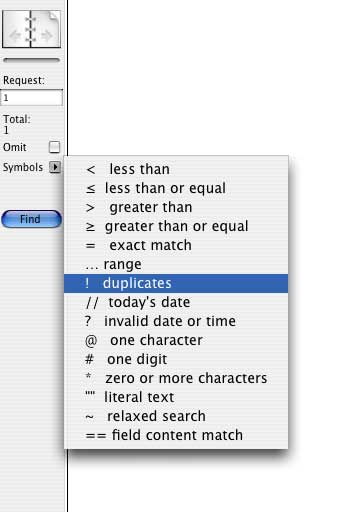FileMaker Pro Session 3
Using the
Find Command
Searching Through Your Data
Finding Records
- Perhaps the most important things you can learn
about using a database are fast and accurate ways to find information in your
database. There are quite a few (about a dozen) different finds or ways that
you can find information. All finds will result in a "current found set."
- You can search for information in your database
file by specifying the criteria (the values you want to find) for the records
you want to see.
- You need to know: (1.) what the data is and
(2.) where it is. You need to know which fields to look through (search).
The more you narrow down the number of places to search, the faster you will
find what you are looking for. The Find request is (usually) not case sensitive. Below
are different kinds of searches:
About Finding Information
- Use Find mode to search the database for specific
records. A search always examines all the records in a database file. As a
result, the search might change the current found set of records.
- You can omit one or several records to reduce
the found set of records.
Find records to:
- locate specific text, numbers, dates, or times
- work with a subset of records in your database
file. After you find records, FileMaker only displays the records found --
called the current found set.
- locate empty fields, duplicate values, invalid
dates, or invalid times
Making a Find Request
To find records, you specify criteria, (the values
you want to find) in a blank find request. The found set matches all the criteria
you specify.
To make a find request:
- Choose the layout you
want to use to find records from the layout pop-up menu.
- Choose Find from the
Mode menu.
- In the blank find request,
enter or select criteria for as many fields as you want to search.
You can't enter search criteria in summary, container, or global fields.
- If necessary, choose
an operator from the Symbols pop-up menu in the status area to refine your
search.

Simple Find
- Simply go to the Mode Menu and say find. It
gives you a kind of relief where you can see where the information is supposed
to go. However, the menu to the left is the Find menu. It looks very much
like the Browse except that it says Find in the Mode menu. Click in a field
(i.e.: First Name "Thomas")
Text String
A text string does not need capital letters. Use
leading characters as a habit (i.e.: "thom")"
Begins with… " Search
Finds any record that starts with a string. It
usually finds more records than you intended. It is useful when you are only
sure of the first few letters of information. This is Filemaker's default
Exact Find — — Exact
Match Search
Use this when you know exactly what
you are looking for, right down to the last letter, space, period, tilde, accent,
and umlaut. It is useful because it is
- efficient (It finds the smallest
number of records.) and
- usually faster (The more precise
the string is that you provide, the faster the database can do the search.)
Used to find an exact value.Tip : "=" will find all records with this
field blank."
Contains" Search
Use this when you only know a few letters somewhere in the
field. Use it sparingly as it is the slowest search. Because it is the least
precise, your database must do much work. Type * and then the text to search on
Find All
- command—J. Finds all the records in the current
database file and leaves you in the current record.
- Use Find All to redisplay all the records after working
with a found set. Find All is always used in Find mode. After performing this
step, FileMaker Pro switches to Browse mode.
Indexing for Speed
- Databases create indexes so that we do not have to look
through each record sequentially. Typically, you index the fields that you
will most often search. This makes searching a great deal faster and easier.
However, indexing too many fields will use too much hard disk space and can
cause a "performance hit.".
- FileMaker Pro can create an index of values for each
text, number, date, time, and calculation field.
- To view the index for a selected field: Choose Paste
Special from the Edit menu, and then choose From Index.
Tip : To
have two words treated as one by the index (for example, Jean Louis): View the
index by whole values or type a hard space (press Option-Space bar) between
the words.
Find Mode Status Area
- In Find mode, use the status area along with menu commands
to create and manage find requests.
- Exact matches of the text you specify
==
(two equal signs)
==John finds John but not John Smith
==John Smith finds John Smith but not Smith, John or John Smithers
Exact matches of whole words you specify
=
=Market finds Market, Market Services, and Ongoing Market Research but not Marketing or Supermarket
=Chris =Smith finds Chris Smith or Smith Chris but not Chris or Christopher Smithson
- use one = for a exact word; use == for exact words

